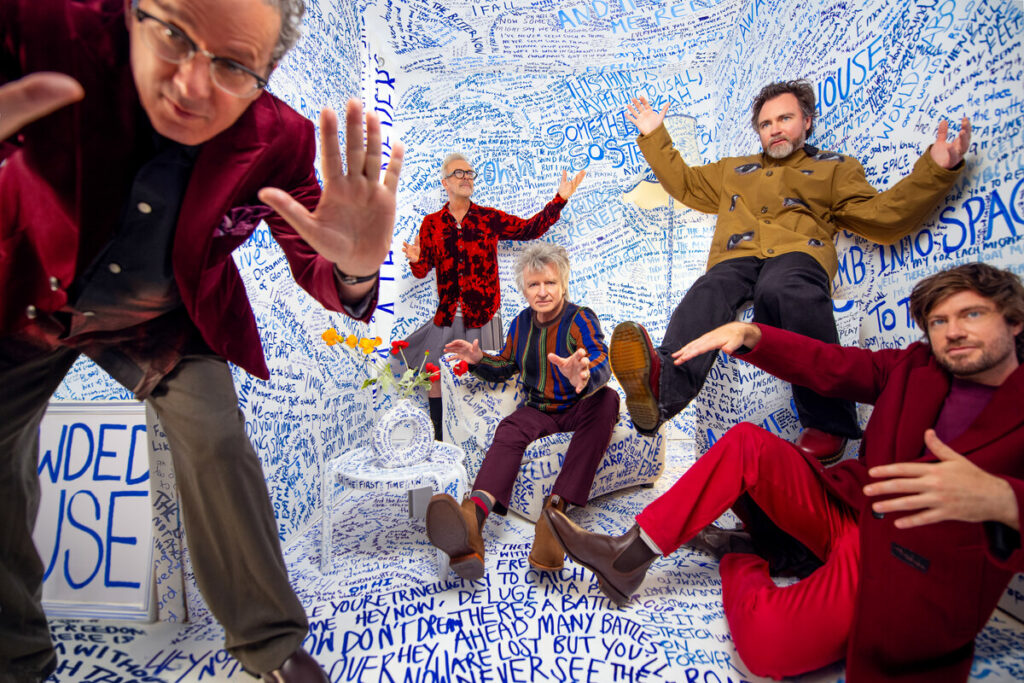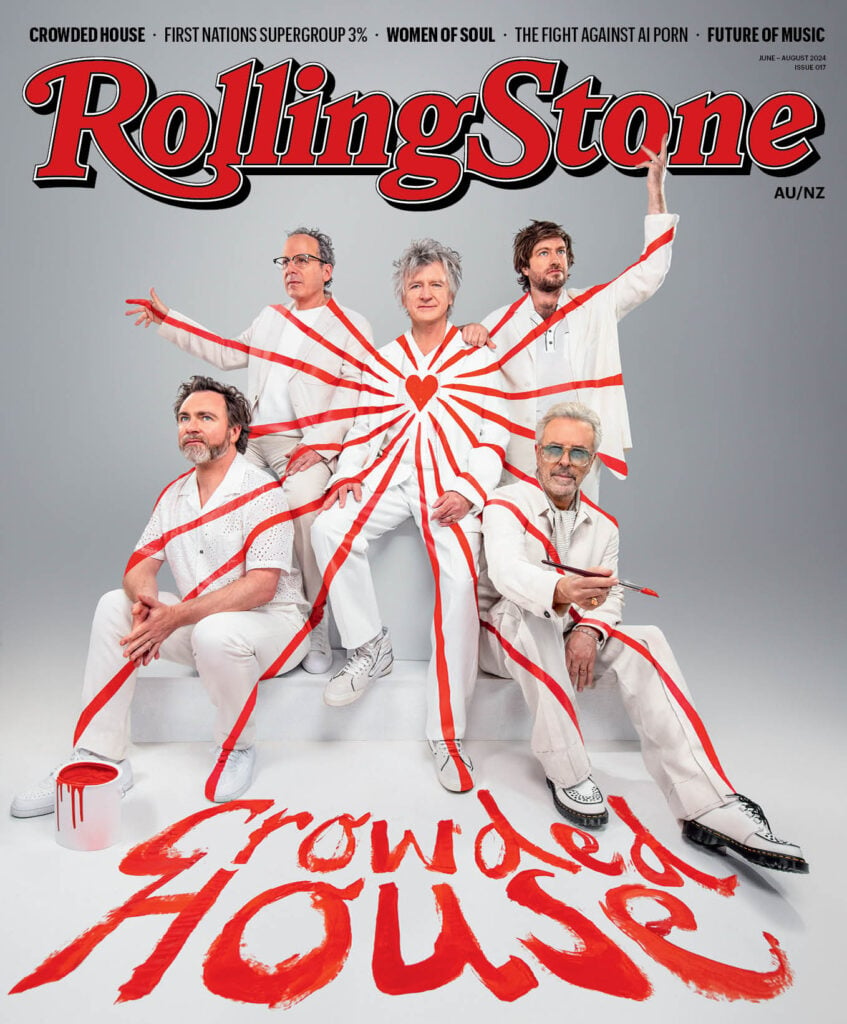Giulia Giannini McGauran
Crowded House: House Is Where the Heart Is
Crowded House welcome us into their private universe to talk about their new album and Neil Finn’s relentless pursuit of the perfect pop song
A perfect pop song is a kind of magic; a compact package of words and music that has the power to propel itself around the world, bring people from all walks of life together, and effectively outlive its creator, achieving immortality.
From the 1980 Split Enz smash “I Got You” to Crowded House’s “Distant Sun” in 1993 and beyond, singer-songwriter Neil Finn is New Zealand’s most prolific author of perfect pop songs, including what may be his most perfect of all: 1986’s “Don’t Dream It’s Over”, an international hit that still inspires spirited singalongs whenever it’s played live.
Witnessing this communion from the vantage point of the Palais Theatre stage in Melbourne on a mild March night is a deeply moving experience. Audience members of all ages rise to their feet, sway in unison and sing their hearts out with unbridled joy. The shift in energy is palpable; the love for Crowded House deep and undeniable.
The band are in town for Global Citizen Nights, an event honouring young activists from across the Asia-Pacific region, and after a well-received mini-set of classics and a couple of songs off brand new album Gravity Stairs, I ask Finn, a boyish 65 despite his greying mop of hair, if the sight of a crowd singing his songs back to him after all these years still has the power to move him.

Crowded House at Global Citizen Nights
“It’s something I never get tired of — I never get blasé about that exchange,” he says. “Sometimes you get a sense of that with an audience — we start a song and you kind of feel a little intake of air, and you sense people moving forward a little bit. It’s a ritual and if you get it right, you do sense that people are having some kind of release. And now it feels more special than it ever did because I’m just amazed at how songs endure and how they become part of people’s lives. It becomes more evident as time goes on.”
Finn believes the reason his sizeable catalogue of songs continues to resonate so strongly with people is due to the fact the meaning of them can be malleable, giving them the ability to apply to vastly different circumstances.
“There’s something [the song] reminds them of, or it was a key moment in their life,” he reasons. “For some people it can be a marker of a death, or a marker of a wedding or the birth of a child. It’s just incredible how [the songs] turn up in different places, and people tell you these stories about what the songs mean to them.”
Love Music?
Get your daily dose of everything happening in Australian/New Zealand music and globally.

Neil Finn at Global Citizen Nights
Finn’s oldest son Liam, 40, a successful solo artist in his own right, was a touring member of the band before joining full-time in 2020. He has, quite understandably, seen more memorable Crowded House gigs than most.
“We were playing a football stadium in Cork a few years ago, and it’s probably the loudest crowd that I’ve ever heard sing the songs back. There’s palpable energy and euphoria that you feel,” he says. “I grew up watching people [react like] that to Dad’s music since I was a kid, and I think that was a huge part of what was attractive to me about being a musician. To put on a show that provides hope and joy and escapism for people is meaningful.”
American Mitchell Froom, 70, who produced Crowded House’s first three albums, played keyboards and organ on “Don’t Dream It’s Over” and finally became a fully-fledged member in 2020, has an accurate take on why people in Australia, the band’s biggest market, have such a deep connection to the music.
“When I come here, it feels like a generational kind of thing, because there’s the parents who loved Crowded House, but then there’s the kids who loved growing up with it. So it’s a very communal feeling, and it’s beautiful,” he says. “The way Neil writes music is very conducive to people being able to sing along to it. And he’s always had that through his family — singalongs at home and all that kind of stuff.”
Also joining the band in 2020 was Neil’s youngest son Elroy, 35, currently drenched in post-show sweat due to a powerhouse drumming performance.
“You don’t get tired of seeing that emotional release happening all at once in an audience; it’s a powerful thing,” he says. “I think it’s given Dad the incentive to keep working so hard as well, because it means a lot to him.”
The audience buzz shows no sign of dissipating as people spill out of the venue at the end of the night, snippets of overheard conversation singing the praises of Crowded House floating through the air — a reminder of how much the band means to fans, too.

L-R: Mitchell Froom, Nick Seymour, Neil Finn, Liam Finn, Elroy Finn
Earlier in the day, after dutifully signing posters and warmly greeting old friends, the band, rounded out by ebullient bassist Nick Seymour, 65 — the only member with a faint whiff of ‘rock star’ about him due to the kind of flamboyant glasses that only famous people can pull off — stroll around a deserted Luna Park to have their photograph taken.
For Seymour, a founding member of Crowded House when they formed in Melbourne in 1985 after Finn’s 1984 exit from Split Enz, his hometown brings back a flood of memories. Even bittersweet ones of the band’s beloved original drummer Paul Hester, who took his own life in 2005 at the age of 46.
“I’m reminded of Paul so much here. He was the king of this city for a time,” Seymour recalls with a wide smile. “Just walking around with Paul Hester in Melbourne Central or St Kilda or Elwood… there was just so much goodwill towards him. He was the voice of the larrikin, disenfranchised, kind of don’t-give-a-shit person.”
I ask what Hester would make of the 2024 version of Crowded House, the one-time trio now a robust five-piece; three of them Finns.
“I think he would absolutely appreciate the fact that we can still go on these jammy little journeys in the middle of songs and have a live dynamic where you’re flying by the seat of your pants,” he says. “The chemistry that we have within Crowded House still mines that same seam of creativity [that we had then].”
Standing on a deck outside a decommissioned tram while a vertigo-inducing rollercoaster looms overhead, Neil Finn says the band’s ties to Melbourne can’t be overstated.
“There’s so much history from over the years — the kids were born here. We lived here. The band started here. We did a lot of our earliest gigs here,” he says. “I wrote probably 90 per cent of the early Crowded House songs in Melbourne, and they all have associations with times and places here… it’s mostly a really lovely, warm, nostalgic feeling.”
Finn admits that more than a few ghosts from the past remain here too.
“It can feel a little haunted at times — the memory pool is heightened in Melbourne, where we did a lot of things together. You see something and think, ‘Oh, gosh, Paul was such a big part of that’… you miss him.
“But it’s nice being back here with Mitchell, because he spent time here recording us. Everyone in Crowded House shares the history, and that’s the great thing about this lineup. It’s different to what it was, but it’s got as much depth and as much soul to my mind as any lineup we’ve had. And potentially it might be our greatest lineup, by whatever measure you use. It feels like we’ve got massive trust now.”
Liam Finn also has a complicated relationship with Melbourne. He lived in the city until he was nine, a time when he first realised his dad was famous thanks to a couple of overzealous Crowded House fans turning up at his primary school. He also spent some time here in his twenties with former band Betchadupa, a period that brings up mixed emotions.
“I love being here, it brings back so many hazy memories,” he says. “I was actually living here when Paul died, which was quite intense. I got the call before my family did because they were all in England. So it was kind of a weird thing to be living back here and then everyone [in Crowded House] came back. I think it was then, at 20, when I realised the connection that Crowded House had, because it was such a heavy time.”
A couple of decades on, he and Elroy were inducted into what is now essentially the family business — the pair even contributing songs to the new album. Liam offers an endearing anecdote about when his dad asked the pair of them to join his world-famous band.
“After he toured as a member of Fleetwood Mac, he knew he wanted to play with Nick again, so he brought it up that way,” he says. “Dad was quite nervous too, because he was pretty unsure about what reaction we would have, because it could go like, ‘Oh, I just want to do my own thing, Dad’. But there’s no one in this world that cares about Crowded House as much as me and Elroy. It’s part of our blood and the legacy is important to us, as well as the band moving forward. We both saw an opportunity to help protect that legacy.”

Crowded House photographed on 9 March 2024 at G.G.McG Studios Melbourne by Giulia Giannini McGauran (@g.g.mcg) Roling Stone Creative Direction Katie Taylor (@ katie.taylor____) Stylist: Jana Bartolo (@janabartolo) HMU: Nadine Muller (@nadinemullermakeup)
After being active from 1985 to 1996 — an era capped by the Farewell to the World concert on the Sydney Opera House steps, which had one of the highest live audiences in Australian history with a crowd size estimated at between 120,000 and 250,000 people — Crowded House reformed between 2006 and 2011, releasing two new albums. The latest chapter for the band began in 2019, resulting in the current lineup and 2021 album Dreamers Are Waiting.
Long gone are the days when Neil, Nick and Paul lived in a literal crowded house in Los Angeles, thus inspiring the group’s name (a replacement for original moniker ‘The Mullanes’, ‘Mullane’ being Finn’s middle name and his mother’s maiden name). Currently, band members are spread all over the globe: Neil in New Zealand, Nick in Ireland, Elroy in London and Liam and Mitchell in LA.
In a section of the Sofitel Melbourne on Collins that’s exclusive enough to feature a secret meeting room hidden behind a mirror — and have Sarah Ferguson, Duchess of York seated at a nearby table — Elroy admits the tyranny of distance created a few complications while making Gravity Stairs.
“We are spread out about as far as you could be, but we had a good amount of practice with international record making over the Covid period [with Dreamers Are Waiting], so it’s not something that’s too foreign,” he says. “There’s been a lot of file sharing involved, but I think the results are unique and cool for that reason, too.”
Despite much of the album being created via computers in different time zones, initial sessions for Gravity Stairs began almost by accident when the band were together in the Hinterlands of Byron Bay in 2022. While rehearsing for an upcoming tour, they decided to try out a few new songs and record them for fun.
“The original tracks that we did in Byron Bay were lush and kind of milky sounding, and the majority of the record is from that first couple of weeks,” says Liam. “We were supposed to be quarantining before a tour and we thought we’d rehearse three songs but wound up doing about nine. We were learning to play the songs and not expressly thinking that we were making a record, so there’s a nice nonchalant looseness to them.”
From there, Neil took the songs back to New Zealand to work on, a process that all the band members acknowledge is a laser-focused process for the Crowded House frontman that often borders on obsession.
“Dad is always going to be working on songs, pushing himself to the edge of madness, to be honest,” says Liam. “He’s the hardest working person I know in the world. And for better or for worse, it just won’t stop.”
Mitchell Froom compares Neil to famed American singer-songwriter Randy Newman, who Froom has produced albums for.
“They’re both kind of relentless and driven, which is beautiful,” says Froom. “A lot of people have a problem with artists as they get older — they just seem to be retreading the same stuff, but some people just keep that fire for music. And these days Neil’s much tougher on himself, so he’ll just keep rewriting so that all of a sudden, the song is now a whole different song. He’ll just keep at it.”
Nick Seymour has been privy to Neil Finn’s creative process for longer than most and says that adhering to incredibly high standards has always been the way his friend of 40 years works.
“There’s times when it can become a pressure cooker type experience, where you’re not sure what is actually under the scrutiny of that desire,” he says. “We all have a desire to get it right. But he is quite obsessive in how deep he will go to describe something that can only be described musically as opposed to verbally. And we do work very, very hard when we are together. But the overriding awareness is to not work too much, to not over-gild the lily, so to speak. It’s a fine line.”

L-R: Liam Finn, Mitchell Froom, Neil Finn, Elroy Finn, Nick Seymour
Later in the afternoon, Seymour has made his way to the famed Bakehouse Studios in Richmond, a sprawling and eccentric rehearsal, recording and filming space that’s seen everyone from Tool to Olivia Newton-John walk through its fabled doors.
Upstairs in a darkened room with wooden floorboards and a selection of musical instruments scattered about — including a guitar case labelled “Finn” — Neil Finn, guitar in hand and facing away from me, sits on a dolly track. He is slowly wheeled backwards, finally rotating around so that our eyes meet — a comical, unintentionally dramatic moment akin to a villain welcoming a foe in their secret lair.
“I have one of these at home — it’s how I greet all my guests,” he quips.
Finn is filming a video for the band’s next single “Life’s Imitation” with renowned music video director Richard Lowenstein, who also helmed the clips for early Crowded House singles “Mean to Me” and “Into Temptation”.
Throughout multiple takes, Finn mimes the song as it plays at double and triple speed. His work ethic and commitment to paying attention to the small details so that everything meets his exacting standards is plain to see. In close quarters, his prime directive is evident: How can I make this the absolute best it can be?
Even though it seems too late to change, Finn even questions whether he has given the band’s new single the correct title.
“We probably should have called it ‘Teenage Summer’ [a lyric in “Life’s Imitation”]. I think we might have made a complete blunder actually, because that’s the line that everybody will probably remember,” he says ruefully.
“We’ve left it too late now. ‘Life’s Imitation’ isn’t quite as good a name really, but initially I thought that was the big hook. ‘Teenage summer’ was the throwaway at the end, but it’s become a rallying cry of sorts.”
In a nearby kitchen area, Seymour enthusiastically explains the art of book carving, showing some impressive examples on his phone that will be incorporated into both the music video and the artwork for Gravity Stairs. The graduate of the Victorian College of the Arts has designed all Crowded House’s album covers and has been intrinsic to the band’s distinct visual identity.
“I still really, really enjoy doing that and I kind of make assumptions that I’m going to be asked to do that,” he laughs. “It’s never challenged and then sometimes I think to myself, ‘I hope I’m not bullying the other guys into me presenting an idea I have for the album cover’ and then feeling like they must have me do it as opposed to going and asking some fine artist of note.
“I’ve always loved bands and artists that have some consistency in their visual output to the actual music that they make. I think that’s important.”
When reflecting on the legacy of what he and the rest of Crowded House have created, Seymour is quick to point out they’ve never been a ‘career band’ driven by a series of clearly defined goals.
“There’s never been a plan, really,” he says. “And there’s never been a sense of the right or wrong decision to make career wise. I still feel like we’re getting away with this somehow. I don’t think we fit into any particular genre. By now, our music is defined by the name ‘Crowded House’, whereas years ago I used to get frustrated that people would know our songs but never associate it with the name. So I guess we’ve defined a brand over many, many years. But that is just the end result of endurance.”
During a break in filming, Finn joins me in a red velvet-lined room that wouldn’t look out of place in an episode of Twin Peaks.
The theme of connection comes up once more — it’s essentially what “Life’s Imitation” is all about — and I ask Finn if he knows when one of his songs is going to make that magical connection with a listener. It turns out one of the key indicators, quite sweetly, is the reaction of Sharon Finn, his wife of 42 years.
“I’ll notice her dance in the doorway as I’m playing something, and I go, ‘I got her, she gets it!’, and that’s a really good feeling,” says Finn. “She loves music, and she’s a great dancer as well, but she doesn’t go for over-intellectualising music. It’s more that she likes to feel it in her hips and get down to it and then sing it. She’s a great sounding board.”
In terms of connecting with those larger audiences who feel compelled to sing along to his songs — those magic combinations of words and music that sound completely effortless despite the painstaking work that goes into them — it’s one of the key things that drives Finn in his eternal pursuit of the next perfect pop song.
“I guess because I’ve been in a band since I was 18, I always like the idea of playing for people,” he says. “The possible effect it might have on a roomful of people, or two or three people or a whole stadium is part of the attraction, there’s no doubt. There’s probably some ego attached to that. But there’s also this sense of tapping into some universal feeling or consciousness — tapping into this thing that makes it feel more OK to be a human.”

L-R: Nick Seymour, Liam Finn, Neil Finn, Elroy Finn, Mitchell Froom
A few weeks later, Neil Finn, minus the rest of the globally scattered members of Crowded House, is in Sydney to accept the Icon Award at the 2024 Rolling Stone Australia Awards.
“This is our new single, ‘Teenage Summer’,” he tells a room full of adoring fans and peers before playing a slightly reworked acoustic version of what was once known as “Life’s Imitation”. The single’s new title is now set to be used for its digital release and anything beyond the first pressing of any physical copies of Gravity Stairs.
It may not be altogether obvious to those in attendance, but what they’re bearing witness to is the key to becoming a genuine musical icon: a restless, relentless artistic heart and mind that’s always in motion; always striving for that magical connection.
This article features in the June-August 2024 issue of Rolling Stone AU/NZ. If you’re eager to get your hands on it, then now is the time to sign up for a subscription.
Whether you’re a fan of music, you’re a supporter of the local music scene, or you enjoy the thrill of print and long form journalism, then Rolling Stone AU/NZ is exactly what you need. Click the link below for more information regarding a magazine subscription.



































